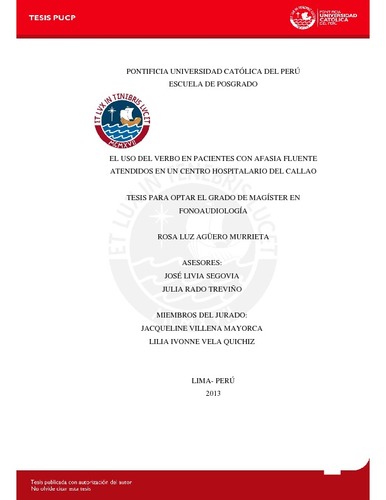| dc.contributor.advisor | Livia Segovia, José Héctor | |
| dc.contributor.advisor | Rado Triveño, Julia | |
| dc.contributor.author | Agüero Murrieta, Rosa Luz | es_ES |
| dc.date.accessioned | 2013-12-06T19:39:38Z | es_ES |
| dc.date.available | 2013-12-06T19:39:38Z | es_ES |
| dc.date.created | 2013 | es_ES |
| dc.date.issued | 2013-12-06 | es_ES |
| dc.identifier.uri | http://hdl.handle.net/20.500.12404/5029 | |
| dc.description.abstract | La presente investigación es un trabajo descriptivo,cuyo objetivo fue identificar las
características del uso del verbo en pacientes con afasia fluente. Participaron de este
estudio seis pacientes afásicos, cuatro diagnosticados con afasia de conducción, uno
con afasia de Wernicke y otro con afasia anómica.
Para obtener los datos se aplicó un protocolo basado en el Test de Boston. La
información sobre el habla espontánea se realizó a través de preguntas de datos de
filiación y descripción de una lámina, las otras tareas fueron: recitado y canto
(completar refranes y cantar tres canciones) repetición de frases y oraciones,
respuesta de denominación y lectura en voz alta.
Se realizó transcripciones para poder analizar el modo, aspecto, tiempo, número y
persona y el tipo de clasificación morfológica de los verbos (regulares e irregulares). 6
El estudio realizado muestra resultados diferentes entre los pacientes según el tipo de
afasia, pues los pacientes que presentaban afasia de Wernicke y anómica utilizaron
más verbos regulares que irregulares confirmando un estudio anterior que hace
referencia a pacientes con afasia anómica. Los otros cuatro pacientes con diagnóstico
de afasia de conducción utilizaron:uno de ellos en misma proporción verbos regulares
e irregulares, los otros tres pacientes utilizaron más verbos irregulares. Con respecto a
las demás características del verbo, se obtuvo como resultado que los pacientes
utilizaron más el modo indicativo, aspecto imperfectivo, tiempo presente y pasado
indefinido, número singular, primeray tercera persona.
Palabras claves:Afasia fluente, afasia de conducción, afasia de Wernicke, afasia
anómica, características del verbo, clasificación morfológica del verbo. | es_ES |
| dc.description.abstract | This research is a descriptive study that aimed to identify characteristics of the use of
the verb in patients with fluent aphasia. Study participants were six aphasic patients,
four diagnosed with conduction aphasia, one with Wernicke's aphasia and one with
anomic aphasia.
To get the data, I applied a protocol based on the Boston naming Test (BNT).
Information on spontaneous speech was made through questions regarding filiation
data and description of a card, the other tasks were: recitation and singing (complete
sayings and sing three songs) repetition of phrases and sentences, naming and reading
response aloud.
Transcripts was performed to analyze the mode, aspect, tense, person and number and
type of morphological classification of verbs (regular and irregular). The study shows different results between patients according to type of aphasia, as
patients with Wernicke's and anomic aphasia used more regular verbs than irregular
verbs confirming a former study referred to patients with anomic aphasia. The other
four patients diagnosed with conduction aphasia used: one of them used both regular
and irregular verbs in the same proportion, three of them used more irregular verbs.
With respect to other features of the verb, it resulted that most patients used the
indicative mode, the present and past absolute tense, singular, first and third person.
Key Words:Fluent Aphasia, Conduction Aphasia, Wernicke Aphasia, Anomic
Aphasia, Characteristics of the Verb, Morphological classification of the Verb. | es_ES |
| dc.language.iso | spa | es_ES |
| dc.publisher | Pontificia Universidad Católica del Perú | es_ES |
| dc.rights | info:eu-repo/semantics/openAccess | es_ES |
| dc.rights.uri | http://creativecommons.org/licenses/by-nc-nd/2.5/pe/ | * |
| dc.subject | Afasia. | es_ES |
| dc.subject | Trastornos del habla--Investigaciones | es_ES |
| dc.subject | Español--Verbo. | es_ES |
| dc.title | El uso del verbo en pacientes con afasia fluente atendidos en un centro hospitalario del Callao. | es_ES |
| dc.type | info:eu-repo/semantics/masterThesis | es_ES |
| thesis.degree.name | Maestro en Fonoaudiología | es_ES |
| thesis.degree.level | Maestría | es_ES |
| thesis.degree.grantor | Pontificia Universidad Católica del Perú. Escuela de Posgrado | es_ES |
| thesis.degree.discipline | Fonoaudiología | es_ES |
| renati.discipline | 916117 | es_ES |
| renati.level | https://purl.org/pe-repo/renati/level#maestro | es_ES |
| renati.type | http://purl.org/pe-repo/renati/type#tesis | es_ES |
| dc.publisher.country | PE | es_ES |
| dc.subject.ocde | https://purl.org/pe-repo/ocde/ford#3.05.03 | es_ES |






